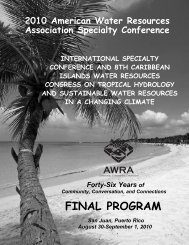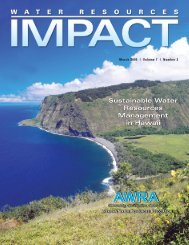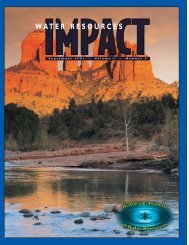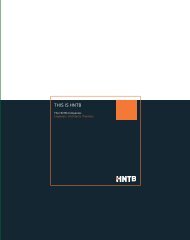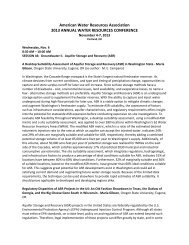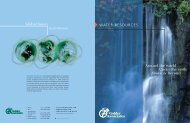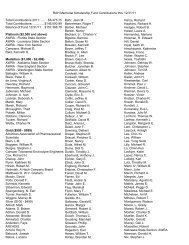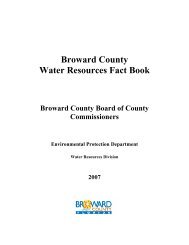Terre Kleen⢠Design Manual
Terre Kleen⢠Design Manual
Terre Kleen⢠Design Manual
Create successful ePaper yourself
Turn your PDF publications into a flip-book with our unique Google optimized e-Paper software.
<strong>Terre</strong> Kleen <strong>Design</strong> <strong>Manual</strong><br />
Introduction to Inclined Plate Sedimentation Technology<br />
Inclined plate sedimentation technology has been used in the drinking water<br />
industry for over 70 years.<br />
<strong>Terre</strong> Kleen has adapted this technology to the stormwater industry (US Patent<br />
6,676,832 B2).<br />
<strong>Terre</strong> Kleen is an inclined plate hydrodynamic separator. The <strong>Terre</strong> Kleen separator is<br />
contained within a HS-25 precast concrete structure. Each stacked overlapping plate is inclined<br />
55º, creating a settling cell containing 6.4 ft 2 of horizontally projected sedimentation surface<br />
area in a precast structure area of only 1.08 ft 2 . This design results in the lowest cost of<br />
sedimentation surface area in the industry.<br />
The precast concrete structure has two (2) chambers. Stormwater<br />
enters the inlet/primary chamber where oil, grease, trash and debris<br />
are floated and permanently captured and coarse sediment<br />
settles. The storm water exits through a screened orifice below the<br />
floatable layer and above the settled layer. The flow enters near the<br />
bottom of the inclined plates; parallel treatment of the divided water<br />
flow occurs as it rises to the top of each plate, where the water<br />
discharges over each cell weir and recombines for discharge<br />
through the effluent pipe.<br />
Gravity separates the sediment particles from the water flow<br />
and the sediment slides on the inclined surfaces to a collection<br />
hopper located below the plates. Baffles separate the captured<br />
sediment in the hopper from the main flow to prevent re-suspension<br />
or scour.<br />
(Picture highlights flow arrow concept for one cell in a nine cell <strong>Terre</strong> Kleen TK09).<br />
<strong>Terre</strong> Kleen NO BY-PASS Treatment <strong>Design</strong>: (See figure 1)<br />
1) <strong>Design</strong> storm flow: 2<strong>Terre</strong> Kleen treats the entire flow and removes sediment as<br />
required under the permit. All floatables such as oil, grease, trash and debris are<br />
removed from the entire flow.<br />
2) Exceeding design storm flow: 3<strong>Terre</strong> Kleen treats the entire flow; sediment in<br />
design storm flow is removed as required under the permit; sediment in the excess flow<br />
is removed at a rate below the permit rate. All floatables such as oil, grease, trash and<br />
debris are removed from the entire flow.<br />
3) Excessive storm flow: 45excessive flow, such as 50/100-year storms do not by-pass<br />
the <strong>Terre</strong> Kleen Treatment for design and excess design flows are as stated above.<br />
The volume of the storm flow unable to flow through the inclined plates enters the<br />
internal flow through duct located between the inlet chamber and the grit chamber.<br />
When the excessive flow exceeds the capacity of the internal flow through duct, this<br />
excess water exits the inlet chamber through a screen located at the top of the baffle<br />
wall and proceeds over the “excess flow weir”. All floatables such as, trash and debris<br />
trapped oil inside the oil booms remain in front of the screen.<br />
Page 1 of 12
4) Maintenance: Cleanout of captured pollutants is required to maintain the design<br />
efficiency of the <strong>Terre</strong> Kleen. When the captured sediment and/or other pollutants<br />
reach the recommended maintenance levels they must be removed to prevent<br />
interference with continued operations. THSS recommends locating the <strong>Terre</strong> Kleen<br />
where a commercial vacuum truck has direct access to the device under its own power.<br />
Disposal cost of the <strong>Terre</strong> Kleen content is about 50% to 70% less than other systems<br />
because the overlapping settling cells reduce the volume of water per effective settling<br />
area<br />
FIGURE 1: <strong>Terre</strong> Kleen Drawing<br />
Plan drawings and details (AutoCAD), suggested specifications, Installation instructions<br />
and Maintenance instructions are at www.terrestorm.com.<br />
75 inches<br />
Figure 1<br />
Page 2 of 12
FIGURE 2:<br />
Inclined Plate Technology Efficiency<br />
Figure 2a is a conventional sedimentation basin. The Q/ (L x W) is the effective rate at<br />
which the water rises towards the overflow weir.<br />
Figure 2b is a horizontal basin where additional floors increase the settling area.<br />
Figure 2c is the equivalent of basin 2b with overlapping inclined plates.<br />
Figure 2d is the basin adapted to facilitate sediment collection in a hopper and multiple<br />
settling cells to maximize settling efficiency and system economy.<br />
Page 3 of 12
Table 1 Inclined Plate <strong>Design</strong> Creates Sedimentation Surface Area<br />
<strong>Terre</strong><br />
Kleen<br />
Model<br />
Footprint<br />
(Structure Ft 2 )<br />
Settling<br />
Surface<br />
Area<br />
(SSA)<br />
SSA per<br />
structure<br />
Ft 2<br />
85% Removal of<br />
OK110-d 50 =110<br />
PSD=53-212 μM<br />
TK09 31.5 ft 2 (4.5’ x 7’) 57 ft 2 180 % 7.9 cfs<br />
TK18 45.5 ft 2 (6.5’ x 7’) 115 ft 2 253 % 16.0 cfs<br />
TK27 59.5 ft 2 (8.5’ x 7’) 173 ft 2 290 % 23.9 cfs<br />
TK36 73.5 ft 2 (10.5’ x 7’) 230 ft 2 313 % 31.9 cfs<br />
TK45 87.5 ft 2 (12.5’ x 7’) 288 ft 2 329 % 40.0 cfs<br />
TK54 101.5 ft 2 (14.5’ x 7’) 346 ft 2 340 % 48.0 cfs<br />
TK63 115.5 ft 2 (16.5’ x 7’) 403 ft 2 349 % 55.9 cfs<br />
Sizing the <strong>Terre</strong> Kleen<br />
The <strong>Terre</strong> Kleen performance has been independently verified :<br />
1. EPA ETV NSF Joint Verification Statement and Report<br />
i. 100% removal rate of 200µm or greater particles in field test<br />
2. Penn State University (PSU) laboratory test<br />
i. 78% net weighted annual TSS removal per NJCAT protocol<br />
3. Alden Laboratory NJCAT Protocol Test<br />
i. 54% net weighted annual TSS removal<br />
Empirical data suggests that the actual Particle Size Distribution (PSD) for “street surface<br />
contaminants” is coarse.<br />
Sansalone, John J. ,Koran, Joseph M., Smithson, Joseph A., Buchberger, Steven G., (1997),<br />
Characteristics of Solids Transported from an Urban Roadway Surface WEFTEC 1997<br />
Sartor, James D. and Gail B. Boyd, (1972), Water Pollution Aspects of Street Surface<br />
Contaminants, EPA-R2-72-081<br />
Shaheen, Donald G. (1975) Contributions of Urban Roadway Usage to Water Pollution, EPA<br />
600/2-75-004<br />
Using the <strong>Terre</strong> Kleen independent 3 rd party tests and adapting them to the above referenced<br />
empirical data; applying the relationships set forth in Stokes’ Law, Chart 1 provides suggested<br />
treatment design flow and peak flows for <strong>Terre</strong> Kleen:<br />
Stokes Law: V particle settling = 2 x R 2 x g x (γ particle – γ water )<br />
9 x ν kinematic<br />
Stokes’ Law calculates the settling velocity of particles in water under certain conditions. The<br />
law sets forth the proportional relationship between the water, the particles, and Gravity. This is<br />
useful in understanding the performance of a hydrodynamic separator when density and particle<br />
size are changed.<br />
Clearly, if g was zero, the V particle settling would be zero. Gravitational force is vertically<br />
downward, therefore, the correct settling area of a cell is the cell’s horizontally projected area.<br />
(see calculation for the stacked inclined plates of a <strong>Terre</strong> Kleen<br />
The particle size R affects the settling speed exponentially. A comparison of different Particle<br />
Size Distributions illustrates this relationship and its effects: when a d 50 =70 Micron is compared<br />
to a d 50 = 100 Micron the settling speed of the 100 Micron particle is 100 2 / 70 2 = 2.04 faster. In<br />
Page 4 of 12
this case, a particle size increase of 42% gives a settling speed increase of 204%. This means<br />
design capacity increases exponentially as the particle size increases.<br />
Plan drawings and details (AutoCAD), suggested specifications, Installation instructions<br />
and Maintenance instructions are at www.terrestorm.com.<br />
NOTE :<br />
The specific size <strong>Terre</strong> Kleen chosen for each specific site will depend upon<br />
the site conditions. The Engineer of Record must make a determination regarding:<br />
1. size of drainage area<br />
2. site characteristics regarding type of soil, particle size distribution and sediment<br />
concentration<br />
3. design of collection and transportation system, which will include pipes sizes and<br />
rates of flow<br />
4. specification of treatment flow<br />
5. specification of peak flow<br />
6. sediment removal rate required by the permit/regulations<br />
7. Additional removal and storage requirements for trash, oil.<br />
8. Space limitations and access conditions<br />
9. Maintenance monitoring methods (i.e. manual or automatic)<br />
Frequently Asked Questions<br />
1. What size particles does a <strong>Terre</strong> Kleen remove?<br />
Answer <strong>Terre</strong> Kleen removes 83% of the net annual weighted SSC with a<br />
PSD of 1 micron to 1000 micron. (Penn State University NJCAT<br />
test)<br />
Answer EPA ETV NSF has verified that the <strong>Terre</strong> Kleen removes 98% of<br />
particles = or > 200 micron<br />
Answer 100% of particles > 50 micron at a surface loading rate of 22.5<br />
gpm/ft² (Alden Laboratory NJCAT test)<br />
2. What amount of trash and debris is removed by the <strong>Terre</strong> Kleen?<br />
<strong>Terre</strong> Kleen removes 100% of trash and debris. The fully baffled<br />
primary chamber and the internal by-pass design results in the<br />
continuous capture of all trash and debris regardless of the flow<br />
intensity. There is no loss of captured trash or debris at any flow.<br />
3. What amount of oil and grease is removed by the <strong>Terre</strong> Kleen?<br />
Answer The <strong>Terre</strong> Kleen uses flotation in the primary (receiving) chamber.<br />
Oil and grease are floated and absorbent booms absorb 1 quart of<br />
oil each. This removes virtually 100% of the oil and grease in<br />
normal stormwater runoff.<br />
4. Does the <strong>Terre</strong> Kleen remove any other pollutants, i.e. phosphorus, glycols<br />
salts, nutrients, etc.?<br />
Nutrients such as phosphorous, nitrogen and other pollutants<br />
such as glycols and salts will be removed if they are attached<br />
to the settled particles.<br />
Colloidal and dissolved particulates adhere or agglutinate to the<br />
coarser particulate. Thus, by settling the coarser pollutants, the<br />
finer particulates are removed by the carrier particle that sinks.<br />
5. Will the water inside of the <strong>Terre</strong> Kleen freeze ?<br />
Page 5 of 12
Inspection of installed <strong>Terre</strong> Kleens has not shown any freezing<br />
of the water inside of a <strong>Terre</strong> Kleen.<br />
6. Will the water in a <strong>Terre</strong> Kleen become a breeding area for mosquitoes?<br />
No. The water in the grit chamber is always enclosed underground.<br />
The water in the primary chamber, even when exposed to the<br />
surface, will not provide a breeding area as it contains an oil and<br />
grease sheen, which discourages mosquito growth.<br />
7. Does installation of a <strong>Terre</strong> Kleen require any special knowledge or<br />
experience?<br />
No. Each <strong>Terre</strong> Kleen is delivered fully assembled within the<br />
precast concrete structure. Installation is no different from the<br />
installation of any precast concrete structure. <strong>Terre</strong> Hill Stormwater<br />
Systems provides an on site person to observe the installation to<br />
assure its proper installation.<br />
8. Does <strong>Terre</strong> Hill Stormwater Systems provide any Warranty ?<br />
Yes. <strong>Terre</strong> Hill provides a four (4) year warranty against defective<br />
products. The warranty includes both labor and material.<br />
9. What is the typical weight for each size <strong>Terre</strong> Kleen ?<br />
TK09 20,300 lbs<br />
TK18 24,600 lbs<br />
TK27 41,300 lbs<br />
TK36 51,200 lbs (no section shall exceed 48,000lbs)<br />
TK45 81,500 lbs (no section shall exceed 48,000lbs)<br />
TK54 90,000 lbs (no section shall exceed 48,000lbs)<br />
TK63 103,000 lbs (no section shall exceed 48,000lbs)<br />
10. What are the Operation & Maintenance (O&M) Costs?<br />
Inspection to document pollutant capture should occur quarterly<br />
during the first year after installation to establish a cleanout cycle.<br />
Generally, cleanout using a vacuum truck will be required 1x every<br />
18 months.<br />
The accumulated sediment, oil, grease, trash and debris must be<br />
disposed of at a licensed, permitted facility.<br />
The water can be decanted back into the <strong>Terre</strong> Kleen, free of the<br />
pollutants.<br />
The O&M annual costs are estimated to be less than 5% of the<br />
total construction costs.<br />
The estimated useful life of a <strong>Terre</strong> Kleen is 100 years; there are no<br />
other maintenance costs expected other than the 18 month routine<br />
clean out cycle.<br />
11. How do the Maintenance costs and procedures compare to other Stormwater<br />
BMPs?<br />
The vacuum clean out process is not time consuming nor complex.<br />
The maintenance procedures for other BMPs such as wet ponds,<br />
wetlands, rain gardens, bio retention facilities and porous<br />
pavements can be time consuming, complex and costly.<br />
Wet ponds and wetlands require dredging to remove sediment<br />
build up. Sediment must be removed to maintain hydraulic loading;<br />
storage capacity; hydraulic residence time and to avoid washout &<br />
scour of sediment and the chemical release of attached<br />
phosphorous caused by anaerobic conditions.<br />
Page 6 of 12
<strong>Terre</strong> Kleen Sizing Chart<br />
Chart 1 illustrates the design flows and peak flow capacities of the various <strong>Terre</strong> Kleen models. This Chart reflects to achieve a 80% net annual<br />
weighted TSS removal efficiency.<br />
Using Chart 1 as a reference, with the site conditions identified, the site specific <strong>Terre</strong> Kleen can be determined.<br />
1<br />
<strong>Terre</strong><br />
Kleen<br />
Model<br />
CHART 1<br />
A B C D E F G H I J K L M N O P Q<br />
Settling<br />
<strong>Design</strong> 1<br />
area in<br />
<strong>Design</strong><br />
<strong>Design</strong> 1<br />
<strong>Design</strong><br />
<strong>Design</strong> 1<br />
<strong>Design</strong><br />
<strong>Design</strong> 1<br />
<strong>Design</strong><br />
Capacity<br />
sedimentation<br />
50 =50<br />
flow head<br />
Capacity<br />
flow head<br />
Capacity<br />
flow head<br />
Capacity<br />
flow head<br />
Peak 2a Peak 2,4<br />
Standard 5 Standard 5 Minimum<br />
max pipe<br />
grade to<br />
d<br />
loss 6 d 50 =110<br />
loss 6 d 50 =150<br />
loss 6 d 50 =200<br />
loss 6 Flow head loss 6<br />
Sediment Trash and<br />
Diam.<br />
pipe<br />
Storage Oil volume<br />
chamber<br />
Micron<br />
Micron<br />
Micron<br />
Micron<br />
invert 3<br />
Standard<br />
pipe invert<br />
to device<br />
bottom<br />
PSD 38-68 μ M PSD 38-300 μ M PSD 38-640 μ M PSD 38-1000 μ M<br />
2 TK02 12.8 sf 0.6 cfs 0.05 In. 1.6 cfs 0.36 In. 2.1 cfs 0.62 In. 2.6 cfs 0.95 In. 4.0 cfs 2.25 In. 18 In. 88 CF 133 Gallon 3.27 Ft 6.25 Ft<br />
3 TK03 19.2 sf 0.9 cfs 0.11 In. 2.3 cfs 0.74 In. 3.2 cfs 1.44 In. 3.8 cfs 2.03 In. 5.4 cfs 4.11 In. 18 In. 88 CF 133 Gallon 3.27 Ft 6.25 Ft<br />
4 TK04 25.6 sf 1.2 cfs 0.20 In. 3.1 cfs 1.35 In. 4.2 cfs 2.48 In. 5.1 cfs 3.66 In. 7.2 cfs 7.30 In. 18 In. 88 CF 133 Gallon 3.27 Ft 6.25 Ft<br />
5 TK05 32.0 sf 1.5 cfs 0.32 In. 3.9 cfs 2.14 In. 5.3 cfs 3.95 In. 6.4 cfs 5.77 In. 9.0 cfs 11.40 In. 18 In. 88 CF 133 Gallon 3.27 Ft 6.25 Ft<br />
6 TK06 38.4 sf 1.8 cfs 0.46 In. 4.7 cfs 3.11 In. 6.3 cfs 5.59 In. 7.7 cfs 8.35 In. 10.8 cfs 16.42 In. 18 In. 88 CF 133 Gallon 3.27 Ft 6.25 Ft<br />
7 TK09 57.0 sf 2.7 cfs 1.03 In. 6.9 cfs 6.70 In. 9.4 cfs 12.44 In. 11.4 cfs 18.30 In. 15.0 cfs 31.70 In. 24 In. 80 CF 175 Gallon 3.27 Ft 6.25 Ft<br />
8 TK18 115.0 sf 5.5 cfs 1.31 In. 14.0 cfs 8.49 In. 18.9 cfs 15.48 In. 22.9 cfs 22.73 In. 28.0 cfs 34.00 In. 36 In. 116 CF 253 Gallon 3.27 Ft 6.25 Ft<br />
9 TK27 172.0 sf 8.2 cfs 1.45 In. 20.9 cfs 9.45 In. 28.3 cfs 17.33 In. 34.3 cfs 25.45 In. 42.0 cfs 38.20 In. 42 In. 151 CF 331 Gallon 3.27 Ft 6.25 Ft<br />
10 TK36 230.0 sf 11.0 cfs 1.58 In. 27.9 cfs 10.18 In. 37.9 cfs 18.79 In. 45.9 cfs 27.56 In. 56.0 cfs 41.00 In. 52 In. 187 CF 409 Gallon 3.27 Ft 6.25 Ft<br />
11 TK45 288.0 sf 13.7 cfs 1.65 In. 35.0 cfs 10.78 In. 47.4 cfs 19.76 In. 57.4 cfs 28.98 In. 70.0 cfs 43.00 In. 60 In. 223 CF 487 Gallon 3.27 Ft 6.25 Ft<br />
12 TK54 346.0 sf 16.5 cfs 1.93 In. 42.0 cfs 12.47 In. 57.0 cfs 22.97 In. 69.0 cfs 33.66 In. 77.0 cfs 42.00 In. 72 In. 259 CF 565 Gallon 3.27 Ft 6.25 Ft<br />
13 TK63 403.0 sf 19.2 cfs 1.96 In. 48.9 cfs 12.72 In. 66.4 cfs 23.46 In. 80.4 cfs 34.40 In. 89.0 cfs 42.00 In. 72 In. 295 CF 643 Gallon 3.27 Ft 6.25 Ft<br />
1. <strong>Design</strong> flow is based on 80% Weighted Removal of sediment per NJDEP Lab. protocol and adjusted for d 50 as indicated and Particle Size Distribution as indicated.<br />
2. Peak headloss is defined by minimum grade to pipe invert distance in standard <strong>Terre</strong> Kleen models. Larger head-losses cause over topping or require increased grade elevations.<br />
2a. Greater peak flow designs create larger head losses. They are optional and avoid external by-pass structures.<br />
3. Add 9" for grade adjust and frame and cover, otherwise cast frame into the lid.<br />
4. Excess design overflow through a screen is possible above insert.<br />
5. Special designs are available to address special design issues.<br />
6. Headloss value is due to the clean insert only. Add water depth in the influent pipe(s) entry and exit losses to this value to find the hydraulic grade line up stream.<br />
Temperature of the water may change average particle size may change particle density may change. All affect the performance directly or<br />
exponentially in case of particle size. Therefore we offer a small range of variables and the relative performance of <strong>Terre</strong> Kleen in CFS.<br />
Page 7 of 12
Additional Considerations:<br />
<strong>Terre</strong> Kleen is fully assembled inside a rectangular precast concrete structure<br />
designed and engineered by <strong>Terre</strong> Hill Stormwater Systems to meet the site-specific<br />
service conditions:<br />
1. <strong>Terre</strong> Hill Storm water Systems is the Engineer of Record for structural integrity<br />
of <strong>Terre</strong> Kleen based on the peripheral site data provided by the Engineer of<br />
Record for the site.<br />
2. Buoyancy conditions may require a bottom flange to be part of the structure.<br />
3. Traffic loading affects the design of the lid.<br />
4. Pipe inverts may require the casting of access manholes into the lid to gain<br />
elevation.<br />
5. Inlet grates may be placed above the primary chamber to allow the <strong>Terre</strong><br />
Kleen to be the last inlet in a design.<br />
6. Pipes may enter the primary chamber between 9 and 3 o’clock at various angles.<br />
The discharge is typically at 6 o’clock.<br />
7. The exterior of the structure may be coated to resist acid surroundings.<br />
8. The <strong>Terre</strong> Kleen insert is a welded plate assembly manufactured from marine<br />
grade aluminum (#5052). Hardware is stainless steel and seals are neoprene<br />
rubber.<br />
9. Lids contain the <strong>Terre</strong> Kleen logo and the words “Stormwater Treatment<br />
Device”.<br />
10. Oil absorption booms that absorb and permanently remove ¼ gallon of oil are<br />
placed in the inlet/primary chamber<br />
11. An additional screening/floatables chamber may be placed prior to <strong>Terre</strong> Kleen<br />
at locations where site conditions/use may warrant, such (i.e. malls, stadiums,<br />
race tracks and other areas where throw away containers are used)<br />
12. A treatment train design is recommended. Use of the <strong>Terre</strong> Kleen as a<br />
pretreatment device will remove oil, grease, litter, trash, debris and sediment<br />
prior to discharge into a filter, a wet pond, a wetlands, a detention or infiltration<br />
basin, rain garden, bio-retention area or other treatment structures.<br />
13. Pretreatment with a <strong>Terre</strong> Kleen will preserve the functionality of the<br />
subsequent treatment BMPs; protect its useful life; and reduce maintenance<br />
costs by: 1) preventing pollutants from entering those devices and 2)<br />
concentrating pollutant removal in the easily accessible <strong>Terre</strong> Kleen.<br />
Maintenance Procedures<br />
Maintenance Record<br />
When a <strong>Terre</strong> Kleen unit is newly installed, frequent inspection is highly<br />
recommended. The design of the <strong>Terre</strong> Kleen unit permits easy inspection. It is<br />
recommended that during the first two years after installation, inspections be performed<br />
at least quarterly for the purpose of noting the rate of sediment and floatable<br />
accumulation.<br />
Attached is a form that may be used for recording information resulting from the<br />
inspections. Maintaining accurate records provides a history of the pollutant<br />
Page 8 of 12
accumulation for this unit and can be used as a comparison to other <strong>Terre</strong> Kleen units<br />
that are in use in your region.<br />
To determine sediment accumulation, a stadia rod or similar measuring device may be<br />
used. Cleaning is recommended when the sediment is found to be at the level shown in<br />
the <strong>Terre</strong> Kleen flow diagram. To avoid underestimating the volume of sediment in the<br />
chamber, care must be exercised in lowering the measuring device to the top of the<br />
sediment pile. The clean-out procedure may occur anytime after a rain event. It is not<br />
necessary to wait for particles to settle due to the high sedimentation efficiency of the<br />
device.<br />
Maintenance Cleaning<br />
The <strong>Terre</strong> Kleen is designed with clear access to the primary and grit chambers. A<br />
vacuum truck, or similar trailer mounted equipment, can be used to clean both<br />
chambers by lowering the suction hose through the openings. The oil and litter in the<br />
primary chamber should be removed first. Depending on the equipment used, it may be<br />
necessary to remove floating trash and debris with a net or rake. To further prevent<br />
discharge of hydrocarbons, “oil absorption booms” were added to the primary chamber<br />
during installation. They will float among the litter and begin to sink as they absorb oil.<br />
The boom size 2¼” Ø x 12” will absorb about a quart of oil and solidify it within the<br />
boom. These booms should be replaced when they become saturated with oil and no<br />
longer appear above the water surface. Depending on the site conditions, the number<br />
of booms can be adjusted up or down. Additional booms can be purchased from <strong>Terre</strong><br />
Hill Concrete Products. ( The sorbent booms are placed in the primary chamber for the<br />
absorption of gasoline; diesel fuel, lube oil, jet fuel, transformer oils, chlorinated<br />
solvents, aromatic solvents, hydraulic oils, and light crude. The sorbent boom is<br />
Rubberizer® boom manufactured by Haz-Mat Response Technologies Inc. A standard<br />
<strong>Terre</strong>Kleen TK09 has 4 booms, TK18 has 8 booms, TK27 has 12 booms, TK36 has<br />
16 booms, TK45 has 20 booms, and TK54 has 25 booms.)<br />
After the oil and litter is removed, the grit chamber can be cleaned out. Finally, switch<br />
back to the primary chamber to remove remaining debris. Water can be sprayed into the<br />
chambers as necessary to loosen debris.<br />
Sludge dispersion manifold<br />
Each <strong>Terre</strong> Kleen water quality device contains a “Sludge Dispersion Manifold”. The<br />
manifold pipes are mounted to the floor underneath the inclined plate settler and<br />
connect to a hose that leads to the clean out opening at grade level. This hose is<br />
pressurized by the vacuum truck’s spray nozzle. While the suction nozzle removes the<br />
captured pollutants, the pressurized manifold sprays water through the small horizontal<br />
holes in the manifold pipes. This water lifts and disperses the sludge blanket causing it<br />
to drain to the suction nozzle.<br />
Page 9 of 12
Disposal<br />
Disposal of removed material will depend on the nature of the drainage area. For<br />
example, sediment collected from a system of stormwater inlets may possibly be<br />
disposed at a landfill after the liquid fraction is decanted at a sewage treatment facility.<br />
Material removed from the <strong>Terre</strong> Kleen must be handled according to local, state, and<br />
federal regulations. Some materials, such as sediment and detritus from lawn areas<br />
may be reused on site, which is often recommended by the local authorities. After the<br />
clean-out procedure is complete, replace the manhole covers securely to the frames for<br />
safety purposes.<br />
Cold Weather Concerns<br />
There is limited data concerning cold weather effects on a properly maintained <strong>Terre</strong><br />
Kleen device. The depth of the structure in the soil insulates it from freezing which is<br />
similar to exposure conditions of septic tanks. When inlets are integrated into the <strong>Terre</strong><br />
Kleen, exposure to freezing may become an issue and may result in more runoff<br />
bypassing the treatment system due to a build-up of snow and ice. Saltwater<br />
stratification in the water may also reduce detention time. Colder temperatures reduce<br />
Page 10 of 12
the settling velocity of particles, which can result in fewer particles being “trapped“. The<br />
amount of grit and sand in the runoff from paved areas may be significantly increased in<br />
the winter, which may warrant more frequent maintenance. Access to the device for<br />
maintenance may be more difficult.<br />
Confined Space Entry<br />
Regular maintenance and clean out does not require confined space entry into the<br />
<strong>Terre</strong> Kleen unit. If confined entry is required, it will need to be performed by qualified<br />
personnel who are properly trained for confined space activity using proper equipment<br />
as per the latest OSHA regulations.<br />
The <strong>Terre</strong> Kleen will trap floatable litter and oils that are not emulsified in the<br />
stormwater runoff. Keep sparks and open flames away when working around a<br />
<strong>Terre</strong> Kleen unit that may contain flammable material.<br />
<strong>Terre</strong> Hill Stormwater Systems manufactures a complete line of stormwater<br />
treatment and management structures designed for NPDES permit compliance:<br />
<strong>Terre</strong> Kleen<br />
<strong>Terre</strong> Arch (patent pending 11/569,437)<br />
<strong>Terre</strong> Box<br />
<strong>Terre</strong> Hill Watertight Joint Seal System (patent pending 12/150,722)<br />
<strong>Terre</strong> Filter (patent pending 61/191,484)<br />
Please contact <strong>Terre</strong> Hill Stormwater Systems :<br />
Dale Groff 717 445 3114 dgroff@terrehill.com<br />
Hans de Bruijn 717 445 3116 hdebruijn@terrehill.com<br />
Gene LaManna 717 445 3111 glamanna@terrehill.com<br />
Page 11 of 12
<strong>Terre</strong> Hill Stormwater Systems<br />
PO Box 10<br />
485 Weaverland Valley Rd<br />
<strong>Terre</strong> Hill, PA 17581<br />
800 242 1509<br />
717 445 3100<br />
717 445 0242 (fax)<br />
www.terrestorm.com<br />
http://terrehillstormwater.blogspot.com/<br />
Page 12 of 12



